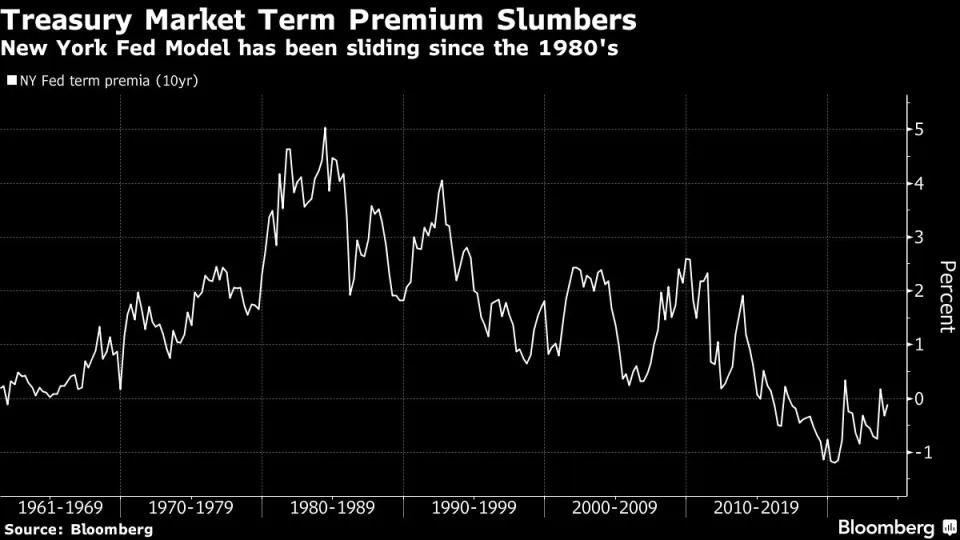From Bloomberg via Yahoo Finance, February 29:
Pacific Investment Management Co. is warning that US fiscal profligacy threatens to drag the Treasury market back to 1980s, a time when bond vigilantes demanded far higher compensation to own longer-dated bonds.

A combination of stickier inflation and deteriorating budget estimates “could start to reverse the 40-year downtrend” of a key measure of how much bond investors are compensated for holding long-term debt, according to Marc Seidner, chief investment officer of non-traditional strategies, and Pramol Dhawan, portfolio manager at Pimco.
“What if we are heading back to the future, to a market resembling prior decades when higher term premiums prevailed?” they asked in a paper published Thursday. Term premium is generally described as the extra yield investors seek to own longer-term debt instead of rolling over into shorter-term securities as they mature. It’s viewed as protection for bond holders against unforeseen risks such as inflation and supply-demand shocks, beyond other drivers of Treasury yields including economic growth and Federal Reserve policy.
Since the global financial crisis, a New York Federal Reserve model of term premia on the 10-year has averaged less than 0.5% and spent considerable time below zero. Last September, this measure briefly turned positive as the 10-year yield shot higher and peaked above 5% the following month amid concerns about US deficits, and the prospect of higher-for-longer Fed policy rates.
While term premium remains slightly negative, bond investors are wary of another climb that in turn could push 10-year yields back toward 5% and spark broader financial market tumult.
“If the term premium returned even to levels common in the late 1990s to early 2000s – around 200 bps – that would likely become the defining feature of financial markets during this era,” the California-based money manager cautioned, adding such an outcome “would not only affect bond prices, but also prices of equities, real estate, and any other asset that is valued based on discounted future cash flows.”....
....MUCH MORE
If interested see also:
October 2023February 5, 2024
"Spiraling Toward A ‘Debt Crisis’?"
As a friend once said to me, there will always be a market for upper, upper-end London real estate, it's just a question of what price and whose pockets have the loot.
Ditto for U.S. debt....
‘Black Swan’ Author Nassim Taleb Is Feeling Gloomy, Says U.S. Is In A Death Spiral
It's not the debt, it's the interest.
Well, the debt too but the terrifying question is "What price will investors demand for giving their money to the U.S. government?"
The problem gets serious
when the price (interest rate) becomes unsustainable and the Federal
Reserve has to resume their bulk buying of treasuries, actually
monetizing the Federal deficit. That's where hyper-inflation comes from,
issuing debt to pay the interest.
Just ask Rudy Havenstein,
—Wall Street Journal, May 1985, via Quote Investigator and a variation earlier that year at
A symposium on the 40th anniversary of the Joint Economic Committee : hearings before the Joint Economic Committee, Congress of the United States, Ninety-ninth Congress, first session, January 16 and 17, 1986 via the Hathi Trust.December 2023
Only The Dead Have Seen The End To Inflation: The U.S. Budget Deficit Continues To Increase
Apologies to Santayana for repurposing his "Only the dead have seen the end to war."*****The problem that will arise is when the interest payments on the public debt become unmanageable.This will happen. Possibly within as little as ten years.
Long before that point the Federal Reserve will be forced to step in and resume net buying the ever-increasing amount of debt required just to repay earlier investors.
That is the definition of a Ponzi scheme. But a scheme so far beyond Chas. Ponzi's dreams as to be an entirely different species, because this Ponzi is guaranteed to take on a life of its own.
When the Fed is buying enough Treasury issuance to monetize the debt there is no turning back, that's the road to hyperinflation, a word we shy away from because its definition, 50% inflation per month, has thus far not even been imaginable in the U.S..
And the 'tell' will be the return of QE, under some guise or another.
Stay tuned.
As the Fed move back to being the buyer of last resort they will opt for financial repression to keep things from spiraling out of control, at least until the current board retires.
We'll post on ways to turn that to your advantage when the time comes.